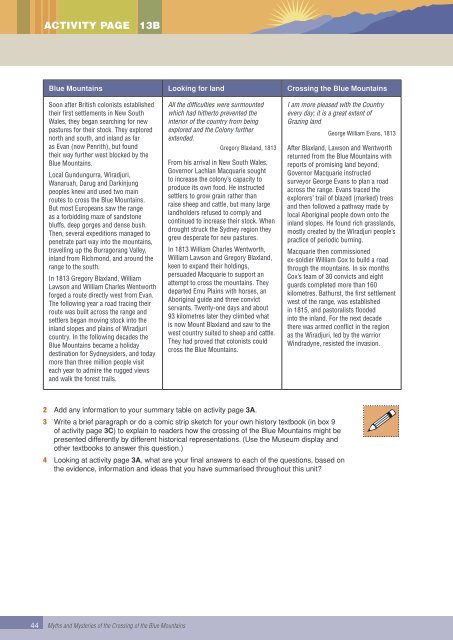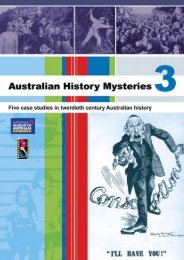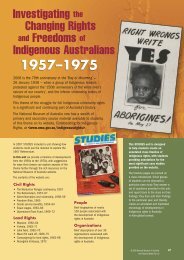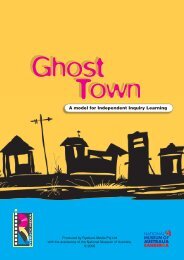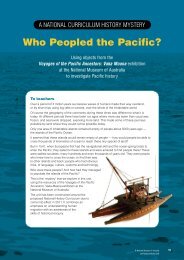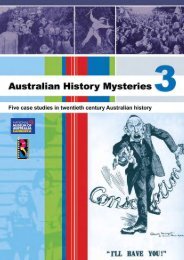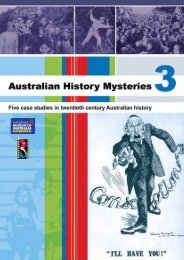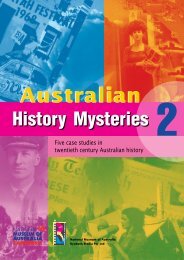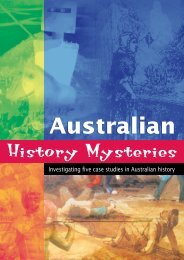Download Teacher Guide & Print Resources - Australian History ...
Download Teacher Guide & Print Resources - Australian History ...
Download Teacher Guide & Print Resources - Australian History ...
You also want an ePaper? Increase the reach of your titles
YUMPU automatically turns print PDFs into web optimized ePapers that Google loves.
Activity page<br />
13B<br />
Blue Mountains Looking for land Crossing the Blue Mountains<br />
Soon after British colonists established<br />
their first settlements in New South<br />
Wales, they began searching for new<br />
pastures for their stock. They explored<br />
north and south, and inland as far<br />
as Evan (now Penrith), but found<br />
their way further west blocked by the<br />
Blue Mountains.<br />
Local Gundungurra, Wiradjuri,<br />
Wanaruah, Darug and Darkinjung<br />
peoples knew and used two main<br />
routes to cross the Blue Mountains.<br />
But most Europeans saw the range<br />
as a forbidding maze of sandstone<br />
bluffs, deep gorges and dense bush.<br />
Then, several expeditions managed to<br />
penetrate part way into the mountains,<br />
travelling up the Burragorang Valley,<br />
inland from Richmond, and around the<br />
range to the south.<br />
In 1813 Gregory Blaxland, William<br />
Lawson and William Charles Wentworth<br />
forged a route directly west from Evan.<br />
The following year a road tracing their<br />
route was built across the range and<br />
settlers began moving stock into the<br />
inland slopes and plains of Wiradjuri<br />
country. In the following decades the<br />
Blue Mountains became a holiday<br />
destination for Sydneysiders, and today<br />
more than three million people visit<br />
each year to admire the rugged views<br />
and walk the forest trails.<br />
All the difficulties were surmounted<br />
which had hitherto prevented the<br />
interior of the country from being<br />
explored and the Colony further<br />
extended.<br />
Gregory Blaxland, 1813<br />
From his arrival in New South Wales,<br />
Governor Lachlan Macquarie sought<br />
to increase the colony’s capacity to<br />
produce its own food. He instructed<br />
settlers to grow grain rather than<br />
raise sheep and cattle, but many large<br />
landholders refused to comply and<br />
continued to increase their stock. When<br />
drought struck the Sydney region they<br />
grew desperate for new pastures.<br />
In 1813 William Charles Wentworth,<br />
William Lawson and Gregory Blaxland,<br />
keen to expand their holdings,<br />
persuaded Macquarie to support an<br />
attempt to cross the mountains. They<br />
departed Emu Plains with horses, an<br />
Aboriginal guide and three convict<br />
servants. Twenty-one days and about<br />
93 kilometres later they climbed what<br />
is now Mount Blaxland and saw to the<br />
west country suited to sheep and cattle.<br />
They had proved that colonists could<br />
cross the Blue Mountains.<br />
I am more pleased with the Country<br />
every day; it is a great extent of<br />
Grazing land<br />
George William Evans, 1813<br />
After Blaxland, Lawson and Wentworth<br />
returned from the Blue Mountains with<br />
reports of promising land beyond,<br />
Governor Macquarie instructed<br />
surveyor George Evans to plan a road<br />
across the range. Evans traced the<br />
explorers’ trail of blazed (marked) trees<br />
and then followed a pathway made by<br />
local Aboriginal people down onto the<br />
inland slopes. He found rich grasslands,<br />
mostly created by the Wiradjuri people’s<br />
practice of periodic burning.<br />
Macquarie then commissioned<br />
ex-soldier William Cox to build a road<br />
through the mountains. In six months<br />
Cox’s team of 30 convicts and eight<br />
guards completed more than 160<br />
kilometres. Bathurst, the first settlement<br />
west of the range, was established<br />
in 1815, and pastoralists flooded<br />
into the inland. For the next decade<br />
there was armed conflict in the region<br />
as the Wiradjuri, led by the warrior<br />
Windradyne, resisted the invasion.<br />
2 Add any information to your summary table on activity page 3A.<br />
3 Write a brief paragraph or do a comic strip sketch for your own history textbook (in box 9<br />
of activity page 3C) to explain to readers how the crossing of the Blue Mountains might be<br />
presented differently by different historical representations. (Use the Museum display and<br />
other textbooks to answer this question.)<br />
4 Looking at activity page 3A, what are your final answers to each of the questions, based on<br />
the evidence, information and ideas that you have summarised throughout this unit?<br />
44<br />
Myths and Mysteries of the Crossing of the Blue Mountains


